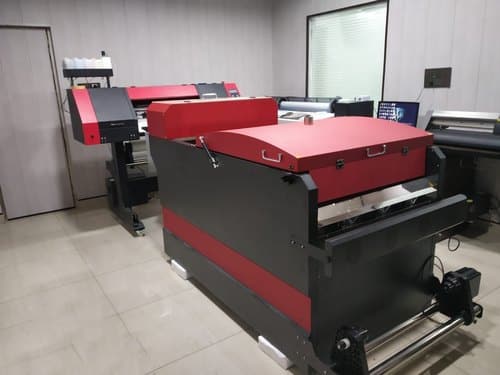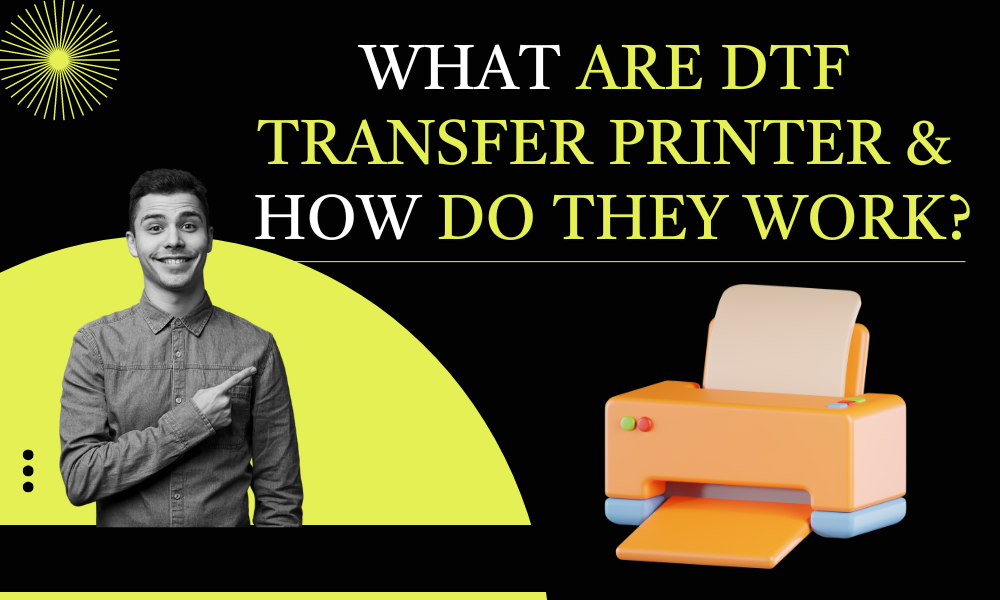This is a complete guide on everything related to Direct Film printers, how DTF transfer printers work in detail, what the different types of DTF printed are, and more. We will explain the whole process of using a DTF printer and how you can make your own custom prints for yourself or your business. DTF printing is a rapidly growing business with huge demand and it does not take a lot of capital to start your own DTF printing business and sell your own custom clothing and printed accessories.
There are many different advantages of using a DTF printing process over other fabric printing methods. You can get a much better color reproduction on your fabric of choice using DTF printing as it does not get mixed with the color of the fabric, the print sits on top of the fabric which also increases the durability of the print. You also have the freedom to use DTF prints on almost any fabric such as cotton or polyester which gives you better flexibility.

What is Direct to Film Printing?
Direct-to-film printing is a process of printing designs on a special transparent film that can then be transferred onto any clothing article of your choice. The transfer of print on the fabric is done using a heat press which is specially designed for different clothing articles such as shirts, caps, and trousers. The prints created using DTF printing last a long time
What are DTF Transfer Printers?
A Direct To Film transfer printer is a specialized printer that can be used to print designs on a number of different surfaces. You can use a DTF printer to print custom designs on T-shirts, caps, socks, and much more. DTF printing is an emerging business and you can offer your customers the ability to print custom prints on their desired article of clothing.
Equipment Needed for Direct-to-Film Printing
Here is a list of things and specialized equipment that you need in order to successfully use your DTF printer for personal and small business to reproduce any desired prints of your choice, take a look.
- A DTF Printer
- PET DTF Transer Films
- PC or Laptop
- Illustration Software
- Specialized DTF Printing Software
- DTF Printer Ink
- Hot-Melt Adhesive Power
- Heat Press Machine
How Does DTF Printer Works?
The printing process of a DTF printer is pretty straightforward. You do not need any expensive equipment or a team of specially trained workers to use a DTF printer. As the name implies, a DTF printer recreates designs on a film, and then the film is used to transfer the print over to any fabric or material of your choice using a heat transfer process.
The whole process of using a DTF printer and how it works is explained below in brief detail, take a look at this step-by-step guide.
Select A Design
The process starts with selecting a design that you want to print. There are many places where you can find really cool designs to print on T-shirts and other materials or you can go ahead and create a custom design of your own using the provided designing software of the printer or any other illustration program. Now that you have selected a design that you want to print, you need to proceed to the next step.
Prep The Printer
The next step is to prepare the printer and make sure it is ready to start printing. The ink used by a DTF printer consists of Yellow, Magenta, Cyan, White and black pigments, make sure it has all of them in the cartridge. Also, check if the printer has enough ink in the cartridges to print the whole design you have in mind and all the sheets that you have planned. Make sure it is plugged into the wall and all the functions of the printer are working as expected.
Insert The PET Film
For this step, you will need to make sure that the specialized PET film is in the paper tray of the printer and ready to be used for printing. This film will be used to transfer the print over to any material of your choice. The PET film used by the DTF printer is about .75 mm thick which means it is thicker than a normal piece of paper and you will not be able to stock as much in the tray as you could stock paper.
Transfer The Design
When you are ready to print the design on the PET film, you need to connect the printer to your computer. Load the design on the integrated software specific to your printer which will automatically create instruction sets for the DTF printer such as the color profiles, drop sizes, and other important parameters that determine the quality of the print. The software is very important for creating a good print using a DTF printer as it will dictate all the important parameters of the final print. You can use this software to send the print to the printer.
Printing on Film
Now the printer will start reproducing the print on the PET film. The speed of printing and the size of the print differs from one printer to another. You can also print multiple designs on a single sheet and cut them to use on a different article of clothing which will bring the operational cost down for your business.
Add Hot-Melt Adhesive Powder
For the print on the film to stick to the fabric, you will need to add the Hot-melt powder which is an adhesive element. This is a white power that will melt between the two when you put the print and the fabric under a heat press and bind the color pigments permanently to the surface of the fabric. The hot-melt power has to be evenly applied to the area of the film on which you want the print on the fabric. If your business experience high traffic and this process seems to take a lot of time then you can also get an automatic power shaker which will do the job automatically depending on the print.
Heat Press
The final step is to transfer the print from the PET film onto the fabric or other surface using a heat press machine. Put the hot-melt adhesive powder-coated film on the fabric where you want the print to be and put it between a heat press. A Heat Press is specialized equipment that helps heats the material along with the PET film to the required temperature and transfer the color pigments from the film over to the fabric. A flat heat press can be used to print T-shirts, pillow covers, canvas, and other flat materials and specially shaped heat press equipment can be used to print other surfaces such as caps, and shoes among other things.
Types of DTF Printers
Most DTF printers currently in use are modified versions of heavy-duty ink tank printers such as the Epson L805, Epson XP 15000, Epson L1800, etc. The reason behind using ink tank printers is that they usually have 6 ink tanks and these ink tanks can be used to store the 6 unique pigments used in DTF printing. A dedicated DTF printing software then uses the location of the different ink in the tanks to make instructions for the printer and helps it reproduce the print on the PET film using its algorithms.
Also Check- Best Epson DTF Printers
Pros and Cons of DTF Printing
There are many different ways to print designs on fabric such as dye sublimation printing, Direct film printing, DTG, etc. and each of them has its respective list of pros and cons. Here are some of the positive and negative points of using DTF printing so that you can weigh both sides of the equation and find out if it works for your business.
Pros
- You can use any material for DTF printing, this method of printing does not limit the user to any predetermined types of fabric like dye sublimation which can only be done on polyester-rich fabrics, you can use DTF on almost all fabrics and different materials.
- The color of the fabric has no effect on the printed pattern as it is on a different level and does not blend with the fabric.
- The prints achieved by the DTF method show a strong wash resistance which means the print will not fade away or get dull with each wash.
- The DTF printing process requires very little pretreatment and you are less likely to mess up your print even if you do not have a very precise work desk.
Cons
- The color reproduction has a lower vibrance and saturation as compared to that of the sublimation prints.
- The printed surface can easily be noticed as it has a different texture than the fabric and can also be identified by sight alone
Conclusion
This was our complete guide on Direct To Film printers, the whole DTF printing process, and other details about the DTF printers to help you make an informed decision. If you have any questions regarding DTF printers, please let us know using the comment section below and we will be happy to help you with the right answers.


